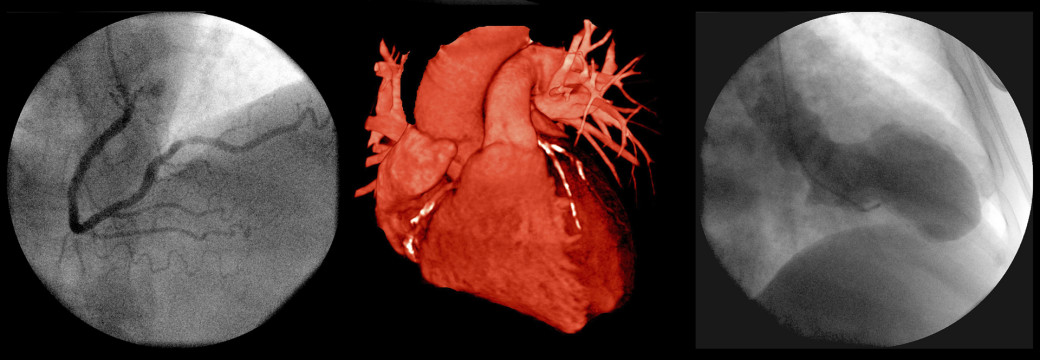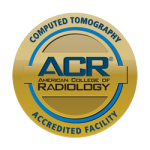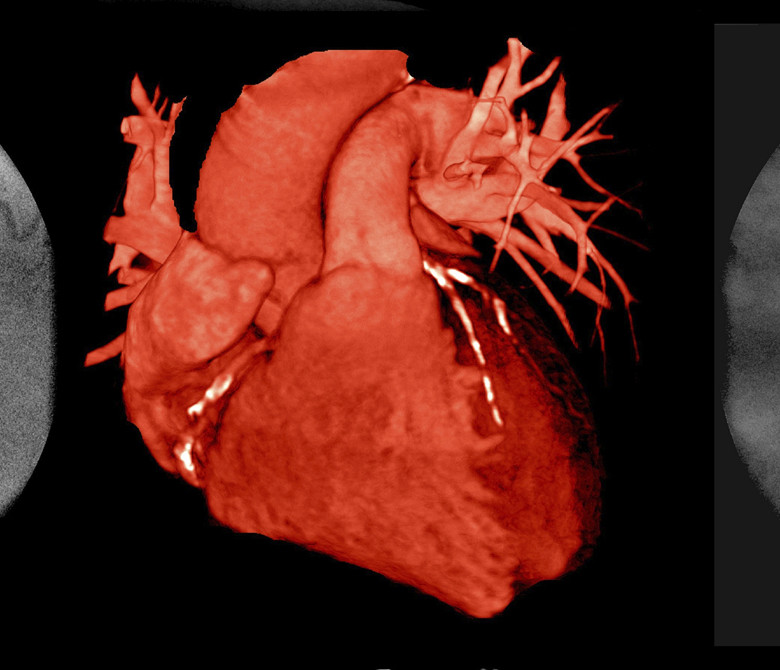CT Angiography (Angiogram or CTA)

Computed tomography angiography – (Angiogram or CTA), uses an injection of iodine-rich contrast material and CT scanning to help diagnose and evaluate blood vessel disease or related conditions, such as aneurysms or blockages.

What is CT Angiography?
Angiography (Angiogram) is a minimally invasive medical test that helps physicians diagnose and treat medical conditions. It is used along with other imaging technologies and, in most cases, a contrast material injection is needed to produce pictures of blood vessels in the body.
Angiography is performed using:
- x-rays with catheters computed tomography (CT)
- magnetic resonance imaging (MRI)
CT angiography uses a CT scanner to produce detailed images of both blood vessels and tissues in various parts of the body. An iodine-rich contrast material (dye) is injected through a small catheter placed in a vein of the arm. A scan is then performed while the contrast flows through the blood vessels to the various organs of the body. After scanning, the images will be processed using a special computer and software and reviewed in different planes and projections.
What are some common uses of the procedure?
CT angiography is used to examine blood vessels and the organs supplied by them in various body parts, including:
- brain
- neck heart chest
- abdomen (such as the kidneys and liver) pelvis
- legs and feet arms and hands
Physicians use this test to diagnose and evaluate many diseases of blood vessels and related conditions such as:
- injury aneurysms
- blockages (including those from blood clots or plaques) disorganized blood vessels and blood supply to tumors
- congenital (birth related) abnormalities of the heart, blood vessels or various parts of the body which might be supplied by abnormal blood vessels
Also, physicians use this exam to check blood vessels following surgery, such as:
- identify abnormalities, such as aneurysms, in the aorta, both in the chest and abdomen, or in other arteries.
- detect atherosclerotic (plaque) disease in the carotid artery of the neck, which may limit blood flow to the brain and cause a stroke.
- identify a small aneurysm or abnormal communications between blood vessels inside the brain or other parts of the body.
- detect atherosclerotic disease that has narrowed the arteries to the legs and help prepare for endovascular intervention or surgery.
- detect disease in the arteries to the kidneys
- guide interventional radiologists and surgeons making repairs to diseased blood vessels, such as implanting stents or evaluating a stent after implantation.
- detect injury to one or more arteries in the neck, chest, abdomen, pelvis or extremities in patients after trauma.
- evaluate arteries feeding a tumor prior to surgery or other procedures such as chemoembolization or selective internal radiation therapy.
- identify dissection or splitting in the aorta in the chest or abdomen or its major branches. show the extent and severity of the effects of coronary artery disease and plan for a surgical operation, such as a coronary bypass and stenting.
- examine pulmonary arteries in the lungs to detect pulmonary embolism (blood clots, such as those traveling from leg veins) or pulmonary arteriovenous malformations.
- look at congenital abnormalities in blood vessels, especially arteries in children (e.g., malformations in the heart or other blood vessels due to congenital heart disease). evaluate obstructions of vessels.
How should I prepare?
You should wear comfortable, loose-fitting clothing to your exam. You will be given a gown to wear during the procedure.
Please leave metal objects, including jewelry, eyeglasses and hairpins at home or you will need to remove them prior to the exam. These items may affect the CT images. You may also be asked to remove hearing aids, removable dental work, underwire garments and possibly body piercings.
You will be asked not to eat or drink anything for a few hours beforehand, as contrast material will be used in your exam. The staff will instruct you upon scheduling your appointment.
You should also inform your physician of all medications you are taking and if you have any allergies, especially a known allergy to contrast material or “dye.” Also inform your doctor of any recent illnesses or other medical conditions and whether you have a history of heart disease, asthma, diabetes, kidney disease or thyroid problems. Any of these conditions may increase the risk of an unusual adverse effect.
Please notify your physician if you are pregnant, breastfeeding, or there is a possibility you are pregnant.
How does the procedure work?
When CT scanning is performed, bones appear white and organs such as the heart or liver show up in shades of gray and air appears black. During the scanning, numerous x-ray beams and a set of electronic x-ray detectors rotate around you, measuring the amount of radiation being absorbed throughout your body. During the test, the examination table is moving through the scanner, so that the x-ray beam follows a spiral path. A special computer program processes this large volume of data to create two-dimensional cross-sectional images (slices) of your body, which are then displayed on a monitor. This technique is called helical or spiral CT.
When the image slices are reassembled by computer software, the result is a very detailed three-dimensional (3-D) view of the body’s interior.
When a contrast material is injected into the bloodstream during the procedure, it clearly defines the blood vessels being examined by making them appear bright white.
How is the procedure performed?
Our technologist will position you on the CT examination table, usually lying flat on your back. Straps and pillows may be used to help you remain still and in the correct position during the exam.
An intravenous catheter (IV), will be administered and an automatic injection pump connected to the IV will give contrast material at a controlled rate. During scanning, the table is positioned at the start point of imaging and will then move relatively rapidly through the opening of the machine as the actual CT scanning is performed.
During CT angiography of the coronary arteries or aorta in the chest, electrocardiogram (ECG) leads (sticky patches) will be placed on your chest to record heart rhythm during scanning. Depending upon how fast and regular your heart beats, your heart rate may be temporarily slowed down for the duration of the exam with medication to obtain motion free images of the heart. If heart rate medication is given, you will be monitored for a short time after the procedure.
Any motion, whether breathing or body movements, can lead to artifacts on the images. This loss of image quality can resemble the blurring seen on a photograph taken of a moving object. Due to this, you may be asked to hold your breath at various times during the exam.
When the examination is completed, our technologist will ask you to wait so they can verify that the images are of high enough quality for accurate interpretation.
If everything is accurate following the exam, the intravenous catheter will be removed and a bandage will be placed over the needle puncture site.
Who interprets the results and how do I get them?
Our radiologist’s with expertise in supervising and interpreting radiology examinations will analyze the images and send an official report to the physician who referred you for the exam, who will discuss the results with you.
Follow-up examinations may be necessary, and your doctor will explain the exact reason why another exam is requested and when to schedule the exam.
What are the benefits vs. risks?
Benefits
Angiography may eliminate the need for surgery. If surgery remains necessary, it can be performed more accurately.
- CT angiography is able to detect narrowing or obstruction of blood vessels allowing for potentially corrective therapy to be done.
- CT angiography may give more precise anatomical detail than magnetic resonance imaging (MRI), particularly in small blood vessels.
- Many patients can undergo CT angiography instead of a conventional catheter angiography (catheterization) to diagnose blood vessel problems.
- Compared to catheter angiography which involves placing a catheter (plastic tube), usually at the groin, into your major blood vessels and injecting contrast material, and may require sedation or general anesthesia, CT angiography is faster, non-invasive and has less complications.
- CT angiography is a useful way of detecting arterial (such as narrowing of blood vessels in the heart) and venous disease as well as structural abnormalities of the heart before there are symptoms or when symptoms are not clearly related to blood vessel disease, such as a heart attack.
- CT angiography is a lower cost examination compared to catheter angiography.
There is also potentially less discomfort because contrast material is injected into an arm vein rather than into a catheter inserted into a large artery or vein. No radiation remains in a patient’s body after a CT examination. X-rays used in CT scans should have no immediate side effects.
Risks
Most patients complete CT angiography with no adverse events.
- There is always a slight chance of cancer from excessive exposure to radiation, however, the benefit of an accurate diagnosis far outweighs the risk.
- If you have a history of allergy to x-ray contrast material, your doctor may advise you to take special precautionary medication, such as a steroid, for a few hours or the day before CT angiography to lessen the chances of allergic reaction. Another option is to undergo a different exam that does not require iodinated contrast material.
- In patients who are at risk for kidney failure and who already have borderline kidney function, administering iodinated contrast material could potentially further damage kidney function. Check with your referring doctor and radiologist to obtain more information regarding this risk.
- If a large amount of x-ray contrast material leaks out from the vein being injected and spreads under the skin where the IV is placed, it may damage the skin, blood vessels and nerves. If you feel any pain or tingling sensation in this area during or immediately after the contrast material injection, you should immediately inform the nurse/technologist.
- Women should always inform their physician and x-ray or CT technologist if there is any possibility that they are pregnant.
- The risk of serious allergic reaction to contrast materials that contain iodine is extremely rare.
Please visit www.Radiologyinfo.org for additional information on this procedure.

